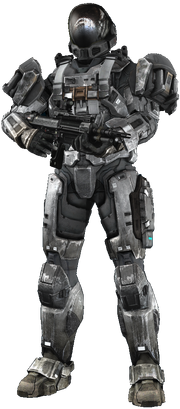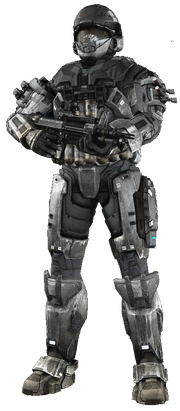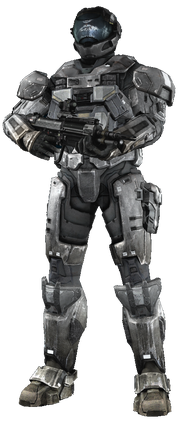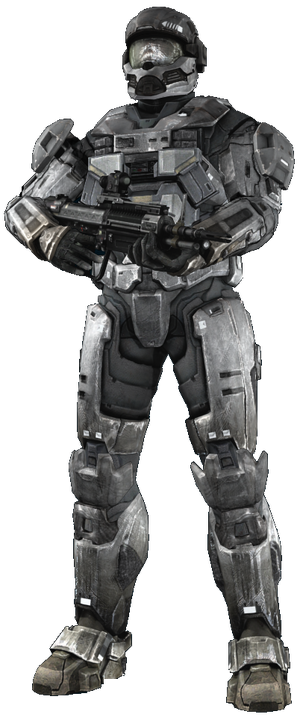Sonasaurus (talk | contribs) No edit summary |
(Adding categories) |
||
| Line 112: | Line 112: | ||
{{AAO UNSC Technology}} |
{{AAO UNSC Technology}} |
||
| + | [[Category:Armor]] |
||
Revision as of 01:51, 26 March 2011
| This fanfiction article, MJOLNIR Mark VII Powered Assault Armor (Maslab), was written by Maslab. Please do not edit this fiction without the writer's permission. |
- "It's like the Mk VI with a 'sneak up and give ’em a wedgie' feature."
- ―Anonymous Spartan
| [Source] | |
The MJOLNIR Mark VII Powered Armor is the next iteration of the famous armor used by Spartan IIs.
Design
The original design of the Mk. VII was still technologically superior compared to the Mk. VI, but it was not designed with the user in mind. The plates were fitted to tightly, requiring a second person to aid in the donning and removal of armor.
In 2565, with the imminent deployment of Delta Company, the armor received an overhaul by Doctor Catherine Halsey. The plates are now fitted so that the Spartan can put the armor on and take it off on their own (although it is still faster with a helper), and there is the addition of various sensory components and gauntlet knives, as Halsey realized that the Spartans would need to be able to stand up to Jiralhanae warriors in melee combat. She also added an active camouflage generator, which increases the weight of the suit but gives a Spartan an even greater advantage on the battlefield.
Aesthetics
The Mark VII is aesthetically similar to the Mark VI version, except for a few additions, including a pack just underneath the fusion power reactor. Armor plates are also smoother, and fit together much tighter.
The visor is also smoothed out, the inline seen in the Mark VI version gone.
There is an extra pair of magnetic weapon holder strips to allow the Spartans to hold an extra weapon.
Functionality
The armor now has two neural interface slots, but can still only support one AI. This allows the user to equip their armor with specialized neural sensors that feed them information directly in to their brain, much faster than eye to brain transmission.
The suit amplifies movements even more, boosting the maximum average running speed of a Delta Company Spartan III to about 160 kilometers per hour.
The neural interface is also more advanced, linked tightly in to the communication system. If needed, an AI can send itself out from the suit in one large packet to another suit with a similar chip. Thus Spartan teams began giving the AI to the squad leader and one of these backup chips to the second in command. If the second in command is killed, then the AI is forced to take another route.
A gauntlet knife has been added, which stabs out from the vambrace in either the right or left arm when the user flexes and straightens their arm.
Armor Components
- Luminous Steel Refractive Titanium Alloy (Exterior)
- Matte Black Alloy (Exterior)
- Magnetic Weapon Holder Strips (Mk. V and all later iterations)
- Shields (Mk. V and all later iterations)
- Hydrostatic Gel
- Reactive Metal Liquid Crystal Layer
- Pressure Seal
- Mk. II Biofoam injectors
- Magnetic boots (Mk. IV and all later versions)
- Active Camouflage Generator (Mk. VII version only)
- Gauntlet Knife
- Variable sensory components
Helmet
Like the previous versions of MJOLNIR, the Mk. VII can be heavily customized to each Spartan's preference. One notable change is the new material used for the visor. The metal compound is originally silver, and is most durable if it isn't visually altered. This also makes the visor less conspicuous than the previous gold. Although the color can be changed if the user desires it, the material can weaken if the integrated colors alter the molecule structure.
The HUD has been upgraded for a higher degree of usability. The flashlight was scrapped in favor of infrared, spectroscopic, x-ray, and high-frequency scanners. Each one can be switched by blinking twice at a symbol in the upper-right corner of the HUD, which will switch modes. Blinking three times within five seconds will reset the view to standard mode. If the user has an AI, they can simply think about which one they want to use at the moment. In some cases the AI can do this for the entire team.
Another new feature is an electrostatic field in front of the visor to keep blood and other debris from obscuring the user's vision.
Gauntlet Knife
The gauntlet knife is a new feature to the Mk. VII. The fuller (center) of the blade is titanium-A, and the flat part of the blade is carbon-fiber. The actual edge of the blade is made of composite material, to give it a long lasting durability and edge, along with the tang and shoulder. A small plasma field surrounds the blade to allow it to punch through shields and parry energy sword attacks. When ejected, the blades are detached from the vambraces and reattached to the gauntlets. This allows the Spartan to swing the blades with small wrist movements, rather than being forced to use their entire forearm.
The blade extends the length of the vambrace, and is unfolded by the user flexing their forearm while making a fist with their hand. The blade then shoots out using magnetic rail systems, and is stopped once the shoulder reaches the wrist. This gives a Spartan an incredible melee capability, combining both their incredible strength and a sharp, impossibly fast blade.
Computer
The computer in the Mk. VII is advanced, taking advantage of graphene processors and chips, which are super-conductive at room temperature (~65o Fahrenheit)
Acquisition of Forerunner memory storage have also been incorporated in to the Mk. VII's design. Now an AI can be stored in the suit without need for upgrades to the neural interface or usage of the user's brain. However, the suit has finite space. Taking in one ninth-generation smart AI will almost max out a standard suit's memory. The user will also not be able to take advantage of the many perks that having an AI can bring, such as decreased response time.
The computer can also track the status of three weapons at once, as well as secondary ordinance (i.e. grenades, demolition charges, energy garrotes).
Energy
To make way for weapon systems such as the .50 Cal Javelin, the Mk. VII was upgraded again in 2575 to conduct energy through the gauntlets and boost the fusion core output.
Special conductive grips on weapons such as the Javelin allow the weapon to make use of the armor's fusion core. However, the armor powers the weapon no matter where it touches it, albeit in a slightly reduced capacity.
These systems are hardened against EMP and armored against a plasma overload.
A fail-safe exists so that the gauntlets are only powered when touching a powered weapon like the Javelin. This ensures that the Spartan does not inadvertently shock allies or any other object.
Variants
There are a few variants of the Mk. VII MJOLNIR armor. Each one is used for a specific purpose.
V Variant

The EVA Variant Mark VII.
The V, or EVA, variant of the Mk. VII MJOLNIR armor is designed specifically for space combat. It maintains most of the aesthetic principles of the Mk. VII, with some important differences. Grapple points, which are really just magnets, are placed at strategic locations on the body for holding on to space objects. The helmet visor extends just above the Spartan's forehead and past the cheekbones. It resembles the Mk. VI EVA helmet except that this visor is closer to the Spartans head.
Special re-breathers have also been added to the back, on either side of the fusion plant and active camouflage generator. These extend the time that a Spartan can survive in a vacuum from 90 minutes to 180 minutes.
The V variant is used by EVA Delta Company Teams.
HALO Variant
The HALO (High Altitude Low Orbit) variant of the Mk. VII was first tested in late 2575. It was chiefly designed by Poseidon Industries with the thought of combining an HEV drop pod with the MJOLNIR armor.

The HALO Variant Mark VII.
The HALO suit is actually an attachment to the standard Mk. VII, which can be quickly jettisoned. It is made of advanced materials and a thick hydrostatic gel layer to absorb as much impact as possible, and has eight high-output jets that slow the Spartan down to a near stop a mere thirty meters above the surface, and completely stop them at five. Once at the five meter mark, the HALO attachment pops off and the Spartan falls to the ground unharmed. Weapons are held underneath the suit while in free-fall, so as not to separate the Spartan with their armament.
This suit was designed after a series of losses in which Spartans were not able to deploy fast enough or in great enough numbers. The percentage of casualties sustained from unassisted HALO drops was also to high. The HALO attachment eliminates both of these problems, as it is easy to equip and slows the Spartan just before impact, reducing casualty rates.
HLS Variant
The HLS (High-Level Stealth) variant was created as a replacement for the Mark II Semi-Powered Infiltration Armor. As per the SPI, the HLS is cheaper to manufacture than the standard-issue MJOLNIR Mark VII, but provides increased protection and stealth capabilities.

The HLS Variant Mark VII.
|
| ||||||||||||

